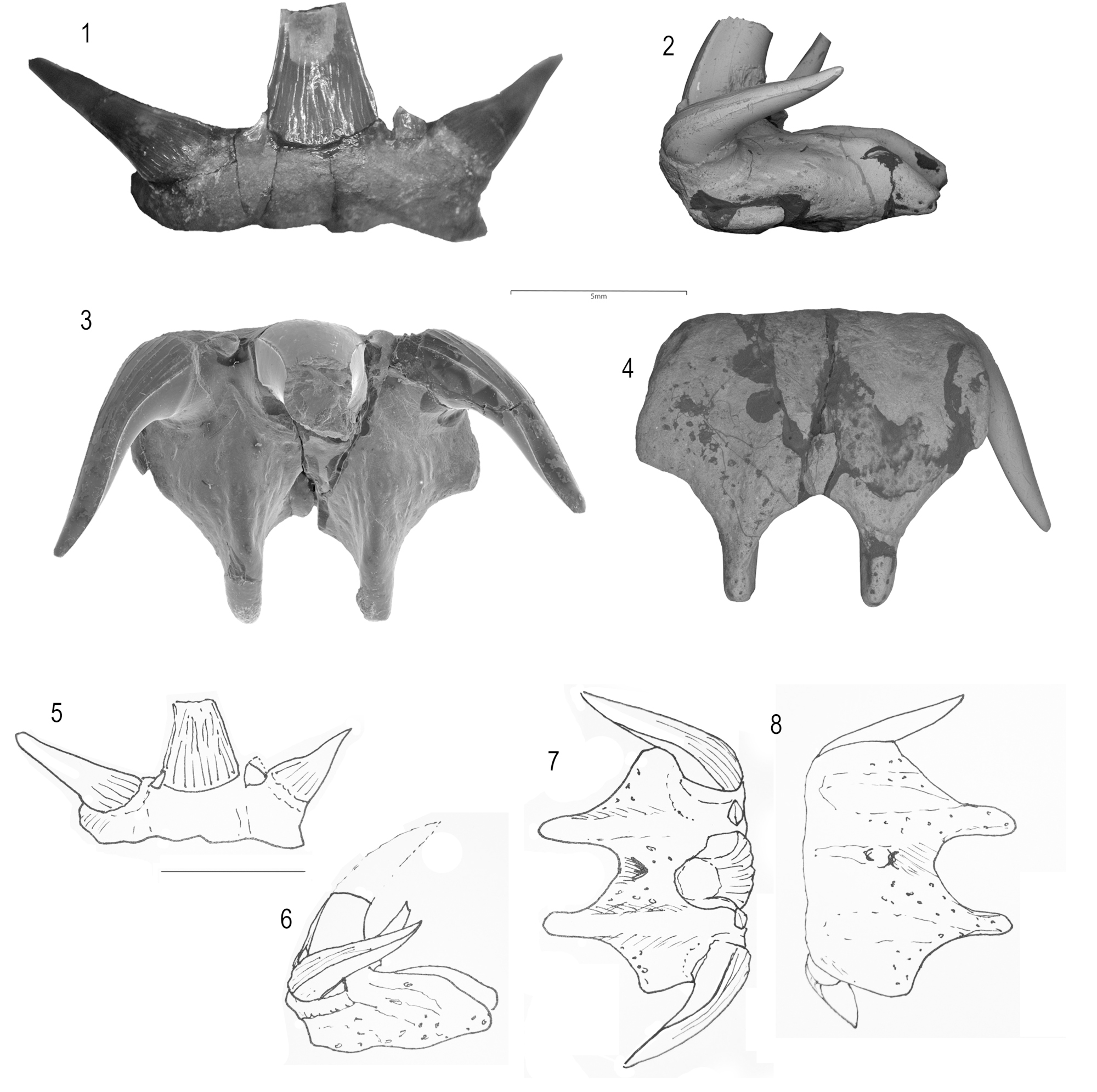Chlamydoselachus kamchaticus
Malyshkina & Nazarkin, 2024
Classification: Elasmobranchii Hexanchiformes Chlamydoselachidae
Reference of the original description
Frilled Sharks (Hexanchiformes, Chlamydoselachidae): New Data on Their Diversity and Distribution. Paleontological Journal, 58, 567–577
Frilled Sharks (Hexanchiformes, Chlamydoselachidae): New Data on Their Diversity and Distribution. Paleontological Journal, 58, 567–577
Description:
Citation: Chlamydoselachus kamchaticus Malyshkina & Nazarkin, 2024: In: Database of fossil elasmobranch teeth www.shark-references.com, World Wide Web electronic publication, Version 01/2026
Please send your images of "Chlamydoselachus kamchaticus" to info@shark-references.com

Chlamydoselachus kamchaticus Malyshkina & Nazarkin, 2024, holotype, coll.no: ZIN 599p, southeastern coast of Karaginsky Island, Kamchatka, Eocene, Priabonian, Peresheek Mountain Formation, Scale bar: 5 mm. © Malyshkina & Nazarkin

Chlamydoselachus kamchaticus Malyshkina & Nazarkin, 2024, holotype, coll.no: ZIN 599p, southeastern coast of Karaginsky Island, Kamchatka, Eocene, Priabonian, Peresheek Mountain Formation, Scale bar: 5 mm. © Malyshkina & Nazarkin
Description
Original description by Malyshkina & Nazarkin, 2024[33559]: The crown of the tooth consists of three main cusps (the central one is broken off at approximately half its height) and two small intermediate cusplets between the central and lateral cusps. When viewed from the labial side (Pl. 6, figs. 1, 5), the central cusp is vertical and the lateral cusps are straight, strongly deviated aside from the central one, and separated from it by spaces about 1/3 of the width of the central cusp base. There is one small intermediate cusplet with distinct cutting edges in each of these spaces. The distal intermediate cusplet is noticeably narrower and lower than the mesial one. When viewed from the side (Pl. 6, figs. 2, 6), the preserved part of the central cusp is almost vertical, slightly curved lingually. The mesial and distal cusps are strongly inclined lingually and have a slight sigmoid curvature. The coronal torque (Fig. 2c) is insignificant. The labial surface of all cusps is covered with sparse ascending anastomosing enameloid folds, generally reaching 1/2–2/3 of the crown height. The lingual surface is smooth. The lateral cusps are slightly swollen in the lower part, which makes the labial surface convex in the lower part and flatter in the upper part. The cutting edge is complete. The neck is distinct, high, and concave (Pl. 6, figs. 2, 6). The root is very wide; its width is twice root length excluding branches (Pl. 6, figs. 3, 7). The root forms large, angular lateral protrusions as a result of its medial and distal expansion. Root branches are long, parallel, laterally compressed, and separated by a wide U-shaped transverse arch. There are smooth labiolingual crests. The central lingual foramen is large, located in a wide, deep, and short central vascular groove on the lingual surface of the root. The basal surface of the root is almost flat and has a smooth but distinct relief (Pl. 6, figs. 4, 8). The distal and mesial basal depressions are narrow and cross the entire root in the labiolingual direction; the central ridge is weakly defined. Basal vascular foramina are recorded throughout the basal face of the root and branches, in particular, in the convex parts, and form a slightly cavernous surface. Measurements in mm (Figs. 2a, 2b): TBW = 10.2, LABW = 8.5, TBL = 8.3.
Original description by Malyshkina & Nazarkin, 2024[33559]: The crown of the tooth consists of three main cusps (the central one is broken off at approximately half its height) and two small intermediate cusplets between the central and lateral cusps. When viewed from the labial side (Pl. 6, figs. 1, 5), the central cusp is vertical and the lateral cusps are straight, strongly deviated aside from the central one, and separated from it by spaces about 1/3 of the width of the central cusp base. There is one small intermediate cusplet with distinct cutting edges in each of these spaces. The distal intermediate cusplet is noticeably narrower and lower than the mesial one. When viewed from the side (Pl. 6, figs. 2, 6), the preserved part of the central cusp is almost vertical, slightly curved lingually. The mesial and distal cusps are strongly inclined lingually and have a slight sigmoid curvature. The coronal torque (Fig. 2c) is insignificant. The labial surface of all cusps is covered with sparse ascending anastomosing enameloid folds, generally reaching 1/2–2/3 of the crown height. The lingual surface is smooth. The lateral cusps are slightly swollen in the lower part, which makes the labial surface convex in the lower part and flatter in the upper part. The cutting edge is complete. The neck is distinct, high, and concave (Pl. 6, figs. 2, 6). The root is very wide; its width is twice root length excluding branches (Pl. 6, figs. 3, 7). The root forms large, angular lateral protrusions as a result of its medial and distal expansion. Root branches are long, parallel, laterally compressed, and separated by a wide U-shaped transverse arch. There are smooth labiolingual crests. The central lingual foramen is large, located in a wide, deep, and short central vascular groove on the lingual surface of the root. The basal surface of the root is almost flat and has a smooth but distinct relief (Pl. 6, figs. 4, 8). The distal and mesial basal depressions are narrow and cross the entire root in the labiolingual direction; the central ridge is weakly defined. Basal vascular foramina are recorded throughout the basal face of the root and branches, in particular, in the convex parts, and form a slightly cavernous surface. Measurements in mm (Figs. 2a, 2b): TBW = 10.2, LABW = 8.5, TBL = 8.3.
Remarks
shark-references Species-ID=17438
shark-references Species-ID=17438
References

Frilled Sharks (Hexanchiformes, Chlamydoselachidae): New Data on Their Diversity and Distribution. Paleontological Journal, 58, 567–577
DOI: 10.1134/S0031030124600665

Frilled Sharks (Hexanchiformes, Chlamydoselachidae): New Data on Their Diversity and Distribution. Paleontological Journal, 58, 567–577
DOI: 10.1134/S0031030124600665
















